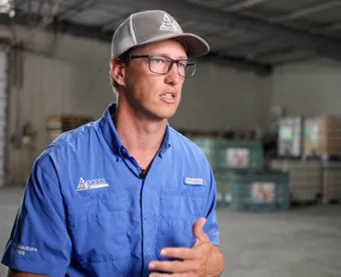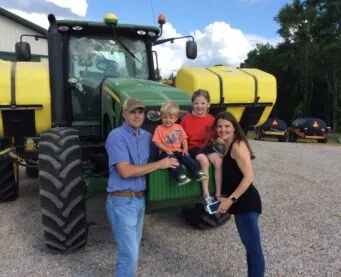This week’s AcreForward podcast welcomed Kansas Dr. Brady Brewer, an economist with Kansas State University who shared his insights on the current state of the farm economy and the important role technology plays in farm profitability.
As a faculty member in the Department of Agricultural Economics, Brewer’s role encompasses a three-way split among teaching, research, and extension services. He also teaches undergraduate courses in agribusiness management and contributes to the Master’s program in Agribusiness. His research primarily focuses on agricultural finance and profitability, particularly how farmers interact with credit markets and supply chain dynamics.
His unique background and ongoing research equip him to both analyze the complexities of the agricultural economy and provide valuable insights into how farmers can navigate financial challenges while leveraging technology for improved efficiency and profitability.
State of the Current Farm Economy
Brewer shared that while the ag economy is in a marked downturn, all is not lost, and we certainly aren’t in a situation of the 1980’s farm crisis, yet. The decrease, Brewer shared is still around the 20-year trend line.
“We’re still above about the 20-year trend of farm income, or we’re right at it. That tells me we’re in a period of adjustment. We saw higher income in 2021, 2022, and 2023, and now we’re returning back to what I would call normal levels of farm profitability,” he shared.
However, the “adjustment” can only last so long before we begin to see a downward trend that impacts balance sheets and borrowing power.
Those higher income years, Brewer says, are a saving grace for farms that are managed well. The liquidity position of farms is crucial for weathering economic challenges, and, for the most part, is strong, and a solid measurement of a business’s ability to meet short-term obligations. The calculation divides current assets by current liabilities…and, like much of farming, a higher is better.
“When we look at the USDA data, we had farms have current rations in 21, 22, and 23 of 3, and even 4, indicating that those operations had 3 or 4 times more current assets than liabilities,” he says. “A current ratio of 2 is generally considered a good position for a farm to be in, and that’s where we are seeing most farms today.”
The strong liquidity position is certainly a buffer against economic challenges; however, Brewer notes that as farmers have been met with high interest rates over the past two years, the drawdown on cash reserves has been significant. Banks have indicated that many farmers have turned to their savings rather than operating loans for essential purchases.
Brewer says that while interest rates have increased rapidly over the past two years, they remain only slightly above historical averages and that the Federal Reserve’s cautious approach to lowering rates stems from lessons learned from past economic crises:
“The Fed has been reluctant to lower interest rates… They remember the seventies and eighties where they lowered interest rates too soon and then we saw even worse inflation. No one wants a repeat of the 80’s.”
Getting a Handle on “Burn Rate”
Brewer suggests that farmers calculate their “burn rate”, which measures how long they can sustain operating challenges without additional income.
“Knowing what your “burn rate” is will aid in better financial management during challenging times,” he says. “Can we last two years? Can we only last a year? The shorter that period is, the shorter “burn rate” you have, the riskier your farming enterprise is.”
Understanding the burn rate allows farmers to assess their financial resilience and make informed decisions about cost management and resource allocation. By extending their burn rate, farmers can reduce their overall risk and better position themselves to weather periods of lower profitability. This metric helps farmers identify essential costs, prioritize expenses, and develop strategies to extend their financial runway during challenging economic times. Ultimately, a well-managed burn rate can provide farmers with valuable time to adjust their operations, seek new opportunities, or wait out market fluctuations without facing immediate financial distress.
Technology Helps Drive Profitability
“Technology is a key piece for farmers in finding profitability in economic downturns,” Brewer says.
Ongoing research with his former Purdue colleagues has revealed that the highest returns in ag technology come from the adoption of bundles of tech.
“We don’t really see a lot of return on the adoption of just auto-steer or just light bars or variable rate seed and fertilizer application. Where we see the highest returns, farmers are adopting four or five technologies.”
He says it makes sense when you think about it – when all of the technologies are talking to one another: collecting yield data allows us to apply variable rate fertilizer and seed.
“Even during tougher times, investing in technology can be beneficial if it improves efficiency or reduces costs,” he says. “And those are questions that farmers will have to answer… if you think you can use it to improve the efficiencies of the farm… those are things I would be turning to in times of lower margin.”




